Kombucha second fermentation done with real fruit makes the most refreshing brew of all. Why? Because kombucha fed with fresh fruit is full of sweet, effervescent bubbles.
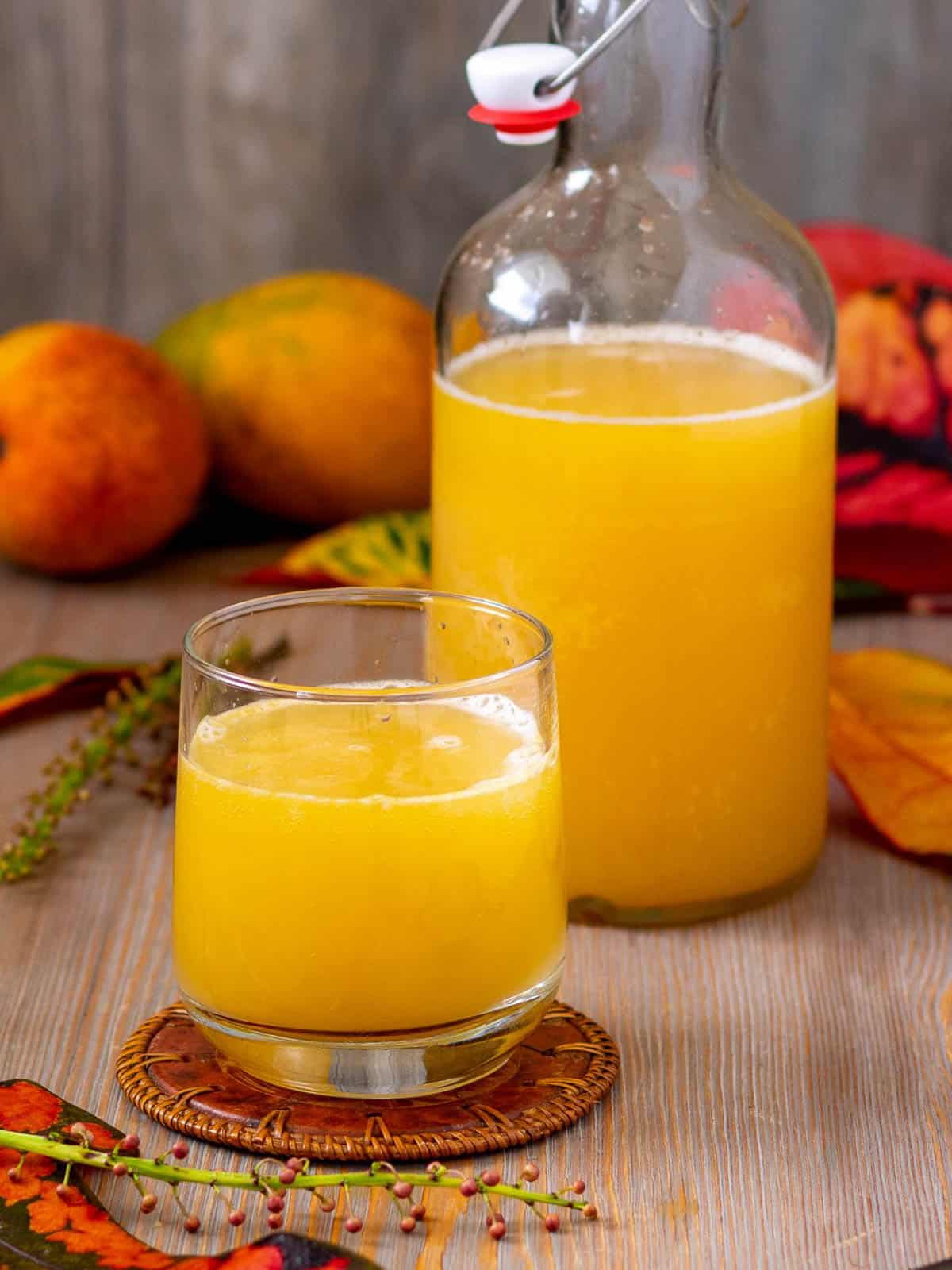
While plain kombucha is full of beneficial probiotics and tasty in its own right, doing a kombucha second fermentation with fresh fruit and sealing it in bottles for 2-4 days is magic by comparison.
You can find seven exotic fruit flavors in this post and the recipe card below, plus tips for creating your own recipe. You’ll be amazed when you pop open your first swing-top bottle, and all that sparkling goodness rushes to the top.
Jump to:
🏆 Top tip
Ferment a portion of your first batch in a plastic soda bottle. It will grow taut as carbonation builds. Then you have a visual clue of how long kombucha second fermentation takes in your climate.
⭐ Why it works
- Real fruit flavors from whole fruit
- Spice and herb combinations
- Not harsh or vinegary
- 100% natural carbonation
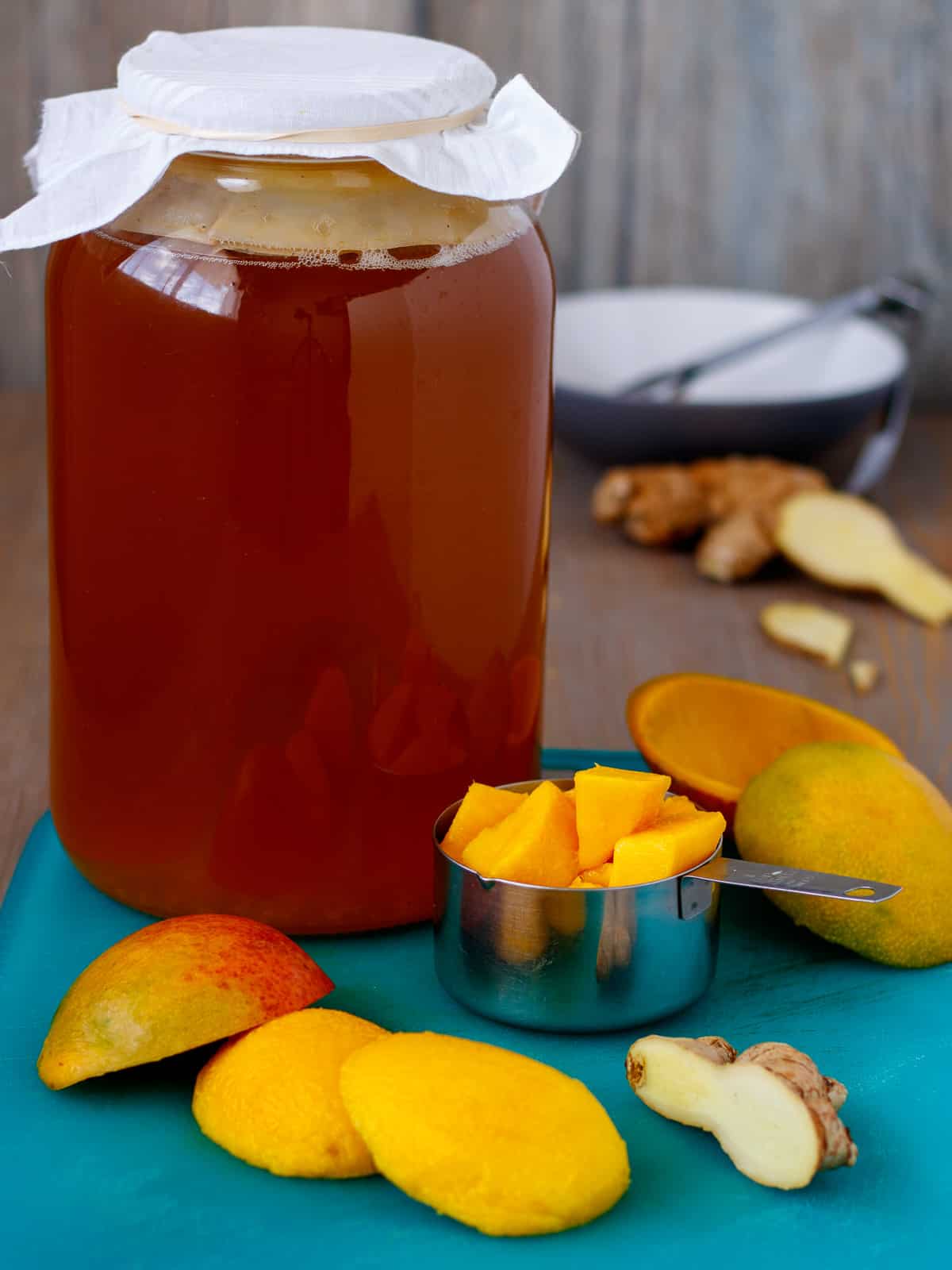
Fresh organic raw fruit made into puree is all you need for the kombucha second fermentation. The quality of the produce you choose will make all the difference. Thus, make sure to use premium ripe fruit for the best-tasting fizzy soda.
It’s marvelous creating different whole-food combinations. You can even incorporate herbs and spices for nuance when flavoring kombucha.
In fact, one of my absolute favorite recipe flavors is Strawberry Purple Basil. You can find it listed below with the other blends designed to help you make your own winning recipes.
📋 Ingredients
It's amazing to think you only need two ingredients and a couple of days' time to brew the best-tasting, refreshing, probiotic beverage.
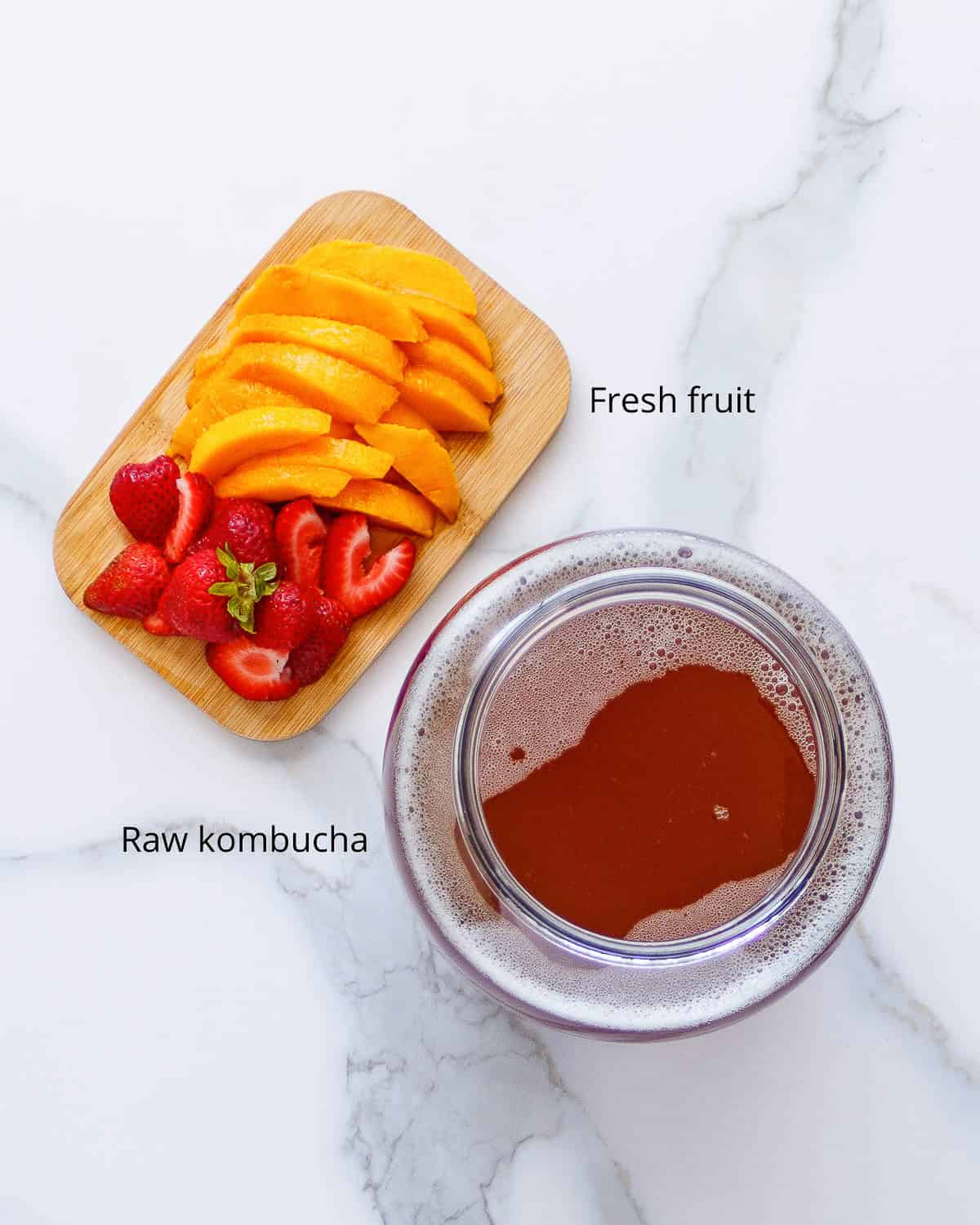
- Fruit - Fresh or frozen will both work, but choose the sweetest and highest quality.
- Kombucha - Plain unpasteurized, or homemade kombucha with live bacteria. Since you need a gallon and store-bought is costly, I highly recommend homemade Kombucha Brew For Pennies.
🥣 Equipment
Here’s a little checklist of items you are likely to have on hand:
- Small bowl - to reserve your SCOBY and starter liquid.
- Large mixing bowl
- Blender - to puree the fruit.
- Funnel - to transfer to bottles.
- Strainer - Fine-mesh, standard kitchen strainer is fine.
You will also need the following equipment:
- Half-gallon glass growlers with fermenting caps. You'll need two.
- Replacement caps - Handy to have in case one gets lost or broken.
- Swing-top bottles - are ideal for storing your finished beverage. They look handsome, lock in freshness and carbonation, and are fun to open and close.
- Bottlebrush - Optional, but go ahead and treat yourself to this savvy clean-up tool.
🔪 Steps
Adding fruit
Making fruit puree and whisking it with plain kombucha only takes a few minutes.
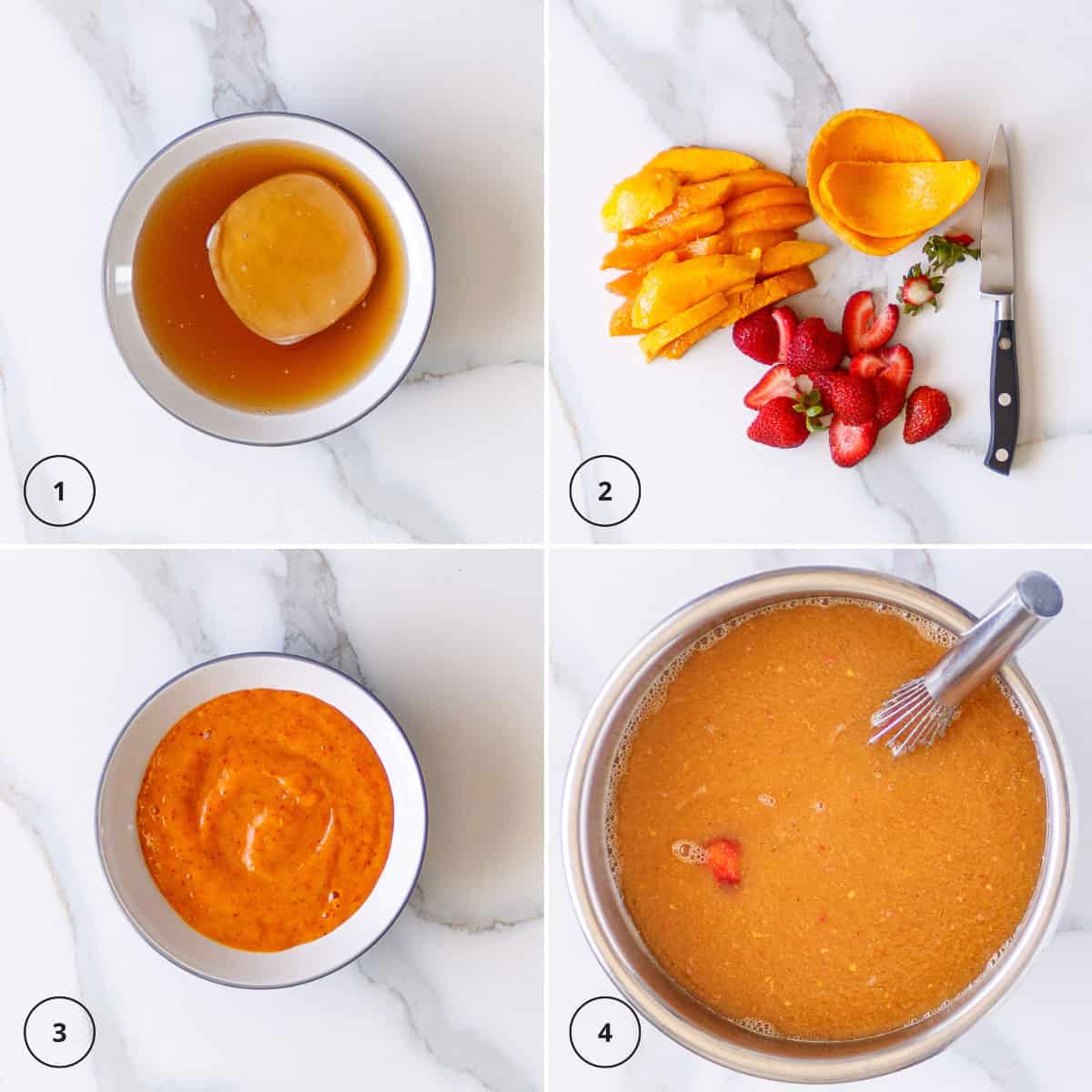
- Set aside the SCOBY and starter from homemade kombucha to brew a new batch.
- Wash, peel, and slice fruit.
- Puree fruit in a blender.
- Mix puree with kombucha in a large bowl.
Carbonating
If you have made homemade unflavored kombucha, you are used to waiting for one to three weeks for your first batch, right? Well, I told you this was going to be easy. Guess what?
Kombucha second fermentation happens as quickly as 2 days in a warm climate. There’s just one important caveat to consider when opening your bubbly half-gallon growlers. Make sure you chill them for 12 hours in a refrigerator before you uncap them.
Otherwise, most of your prize health drink will end up spewing onto the counter before you can strain it into your lovely swing-top bottles.
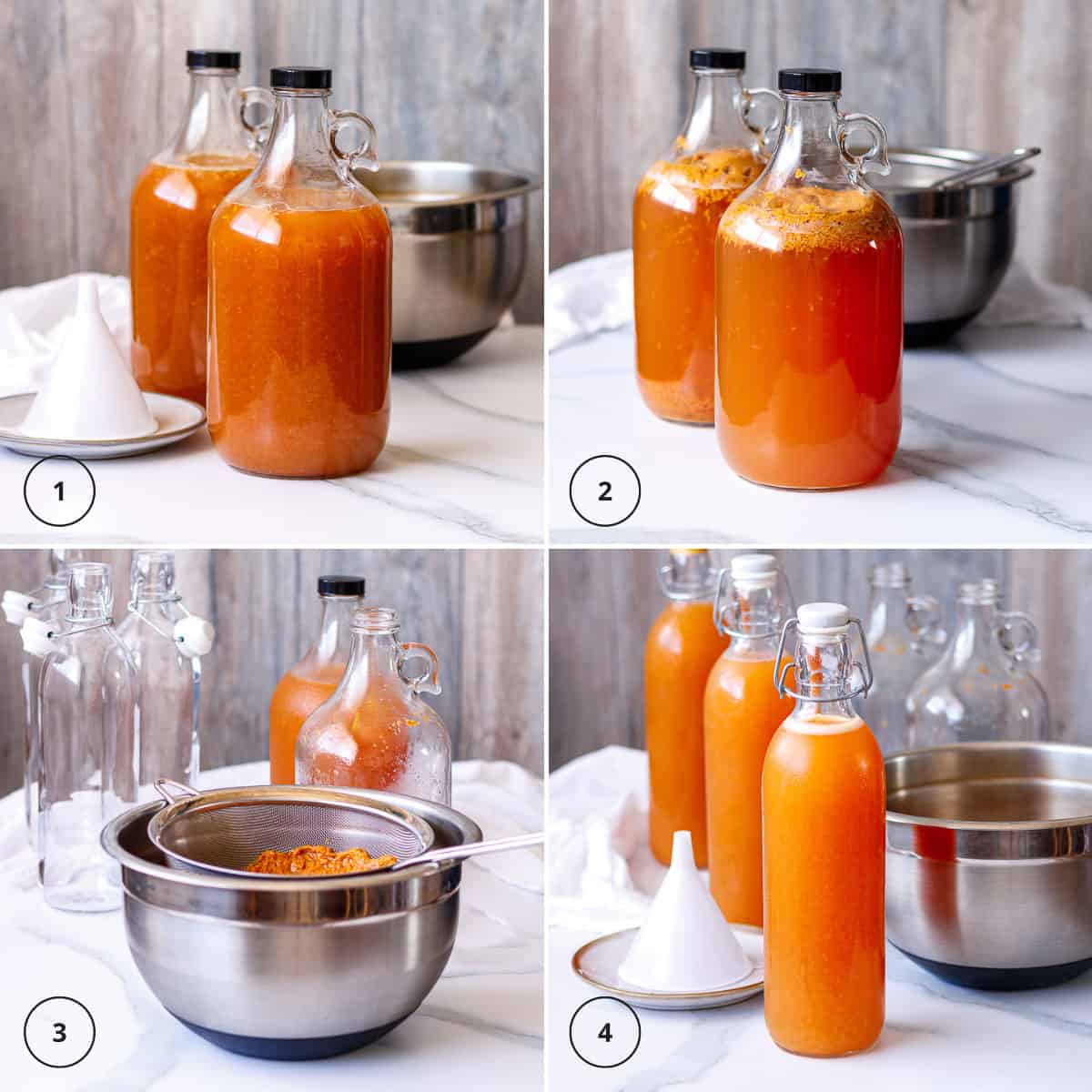
- Pour fruited kombucha into growlers and cap tightly.
- Ferment for 2-6 days and chill for 12 hours.
- Strain to remove fruit pulp.
- Transfer the strained mixture to swing-top bottles for storage.
🫧 Natural carbonation
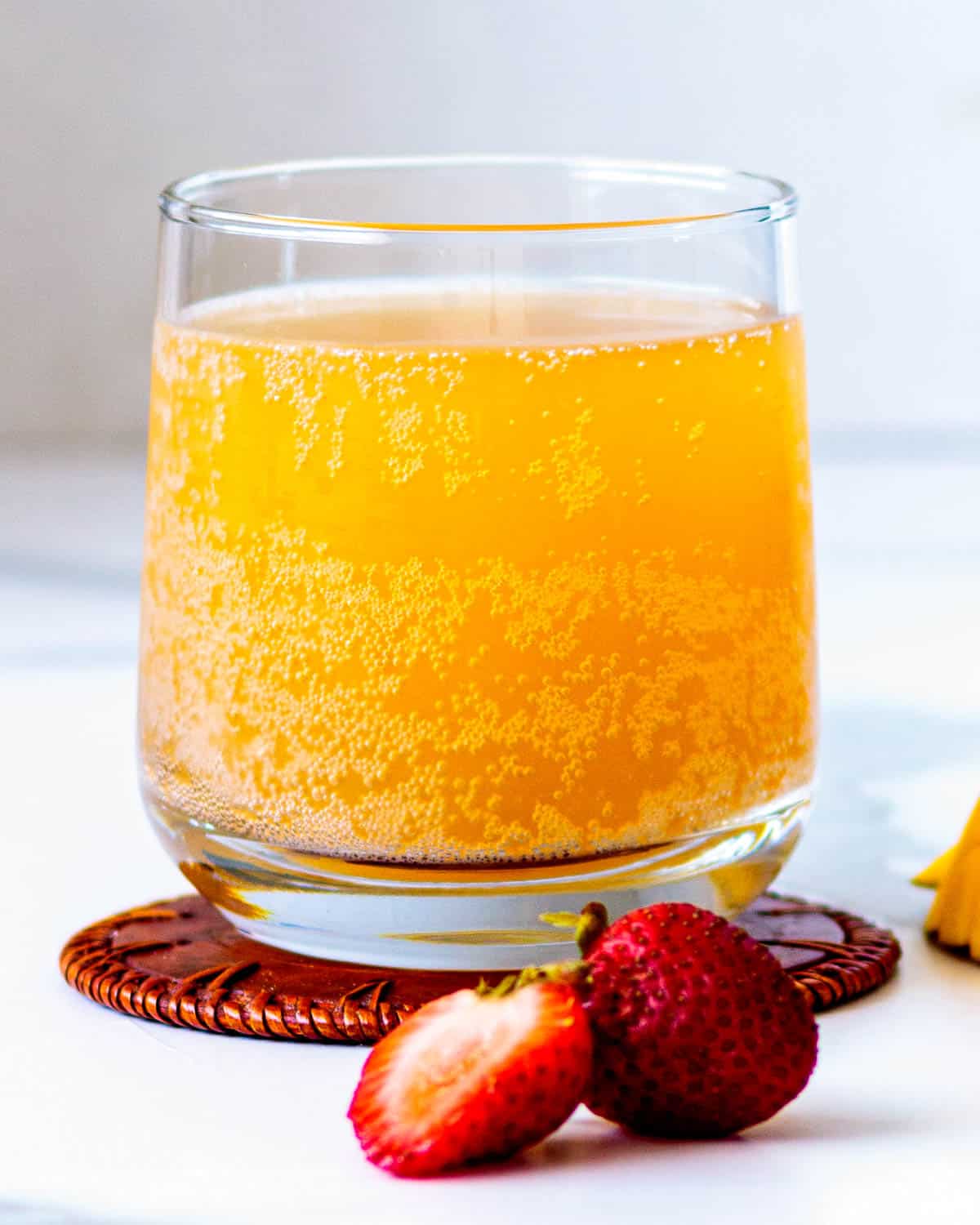
Did you know that most kombucha on the market has artificial carbonation added to it by a machine during bottling? It's understandable when you consider the practical concerns of mass manufacturing.
After all, kombucha is a living thing, and variances are bound to occur. This makes uniformity a challenge in large-scale productions.
Isn’t it cool you can take extra pride in knowing there isn’t anything artificial about your home-brewed bubbles?
Feeding homemade kombucha with fruit and doing kombucha second fermentation in airtight bottles creates robust carbonation that's completely natural. The bubbles are plentiful and round without the sharp edge of brews forced with CO2.
👩🏼⚕️ Safety
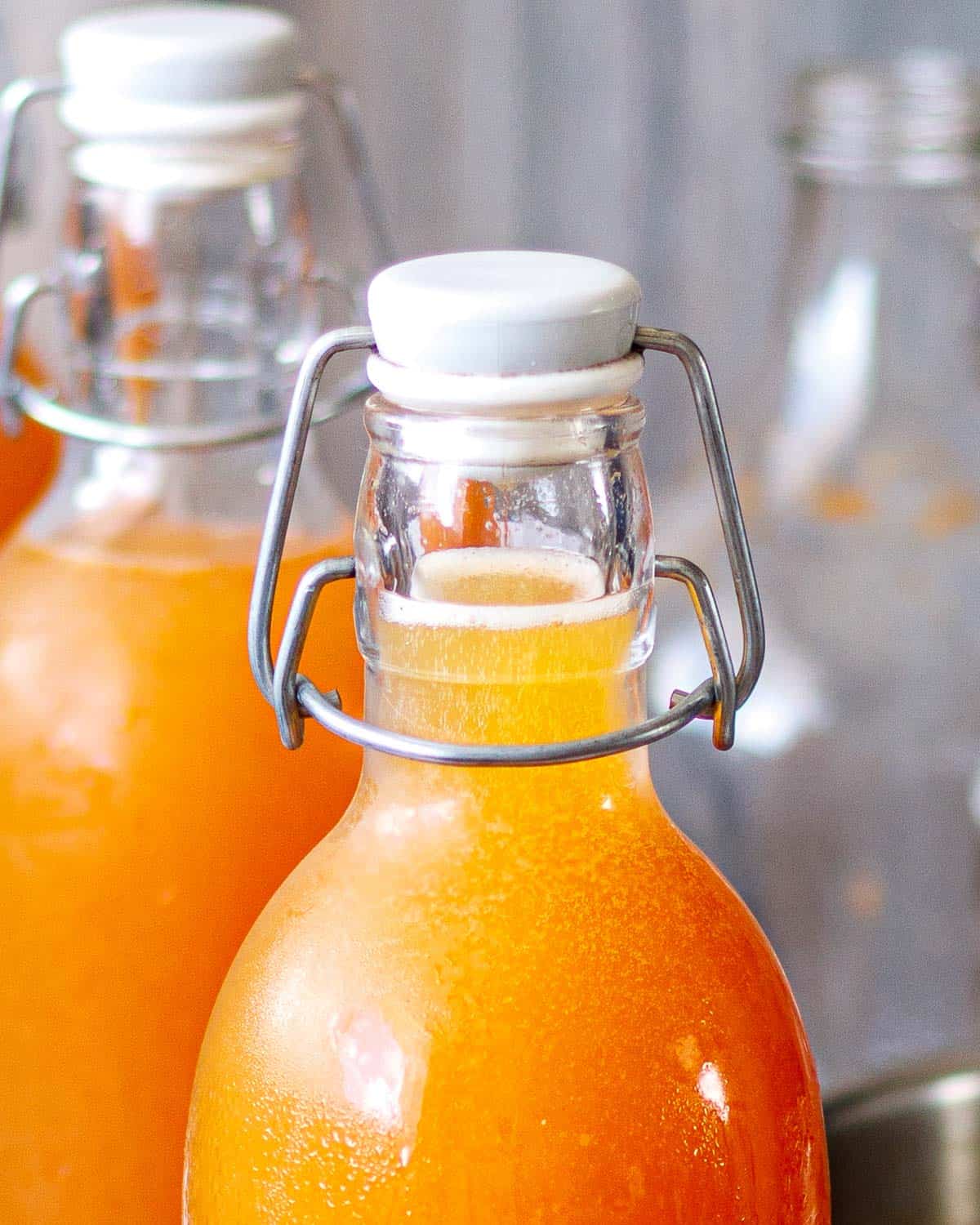
Sturdy glass vessels and lids intended for fermenting will minimize the possibility of explosions. If that sounds scary, know that it's a rare occurrence.
I actually enjoy remembering the two times it happened to me. They were over the course of doing second fermentations continuously for eight years. Nevertheless, we got a thrill and a good laugh!
Don’t worry though, I've learned. Explosions are entirely preventable, and I've passed on safety tips in the recipe below if you don’t want the extra fun and mess.
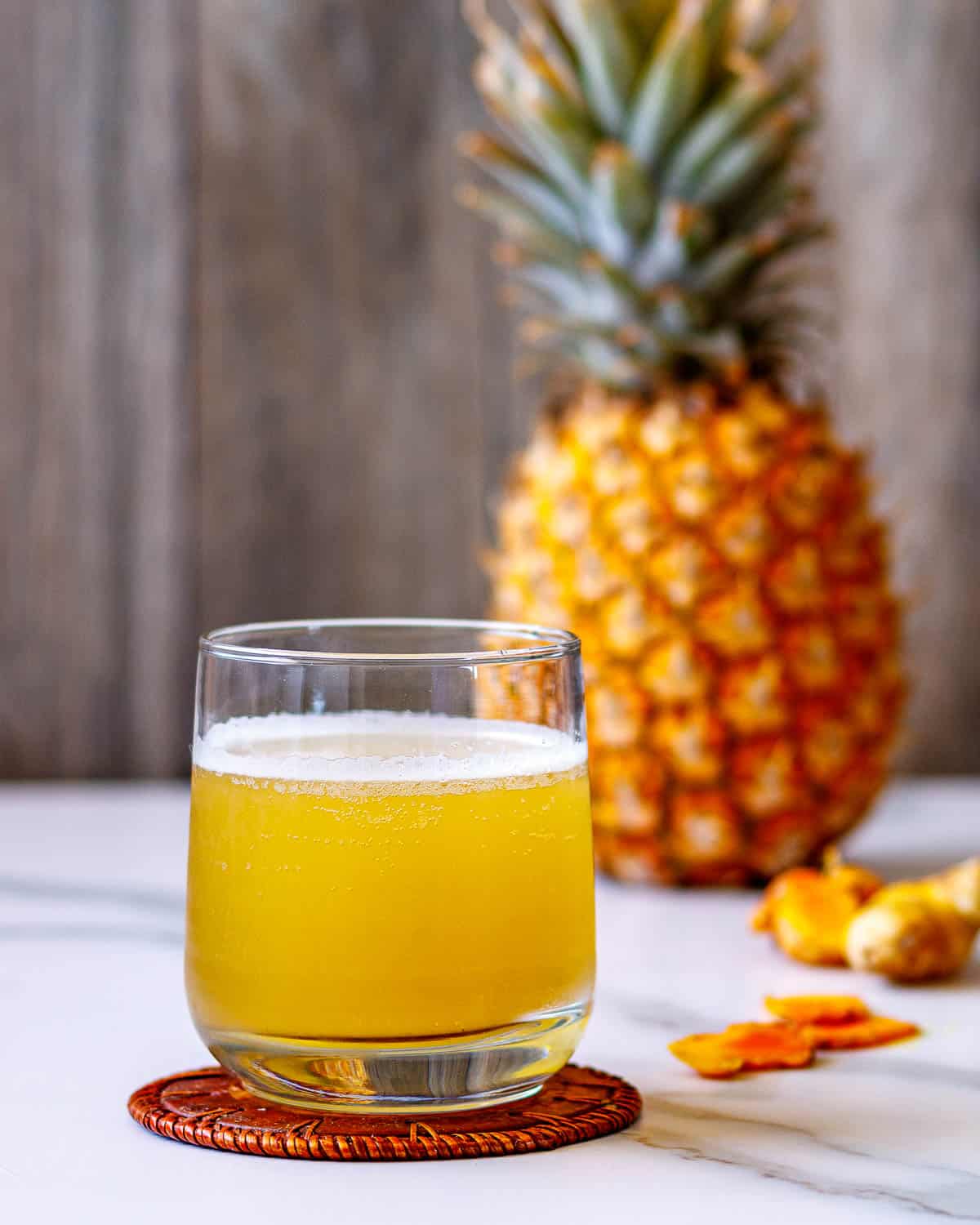
👩🏻🍳 Expert tips
- High-quality fruit with great taste makes the best-flavored brews.
- Limit selection to one to three fruits and/or spices for best success.
- Live bacteria in your kombucha is essential. Ensure that it is raw and vital.
- Bottles and caps designed for second-fermentation brews are a must.
- Store the flavored kombucha second fermentation in a dark cupboard.
- Chill your finished brew before uncapping it to prevent spilling or explosions.
- Swing-top bottles are the best containers to keep finished flavored and carbonated kombucha in. They will keep the carbonation trapped and are easy to pour from. Always store your final brew in the refrigerator.
💭 FAQ
Yes, fresh-squeezed fruit juice without any additives can be used with, or in place of fruit puree. You may need to experiment with the amounts, but I recommend starting with half the measure of the sliced whole fruit.
Just like the first fermentation of kombucha, the kombucha second fermentation likes a warm environment. Temperatures between 75 degrees and 85 degrees are optimal.
🍹 Flavored kombucha recipes
Here are 7 of our favorite tried and true recipes I have used over the years for kombucha second fermentation.
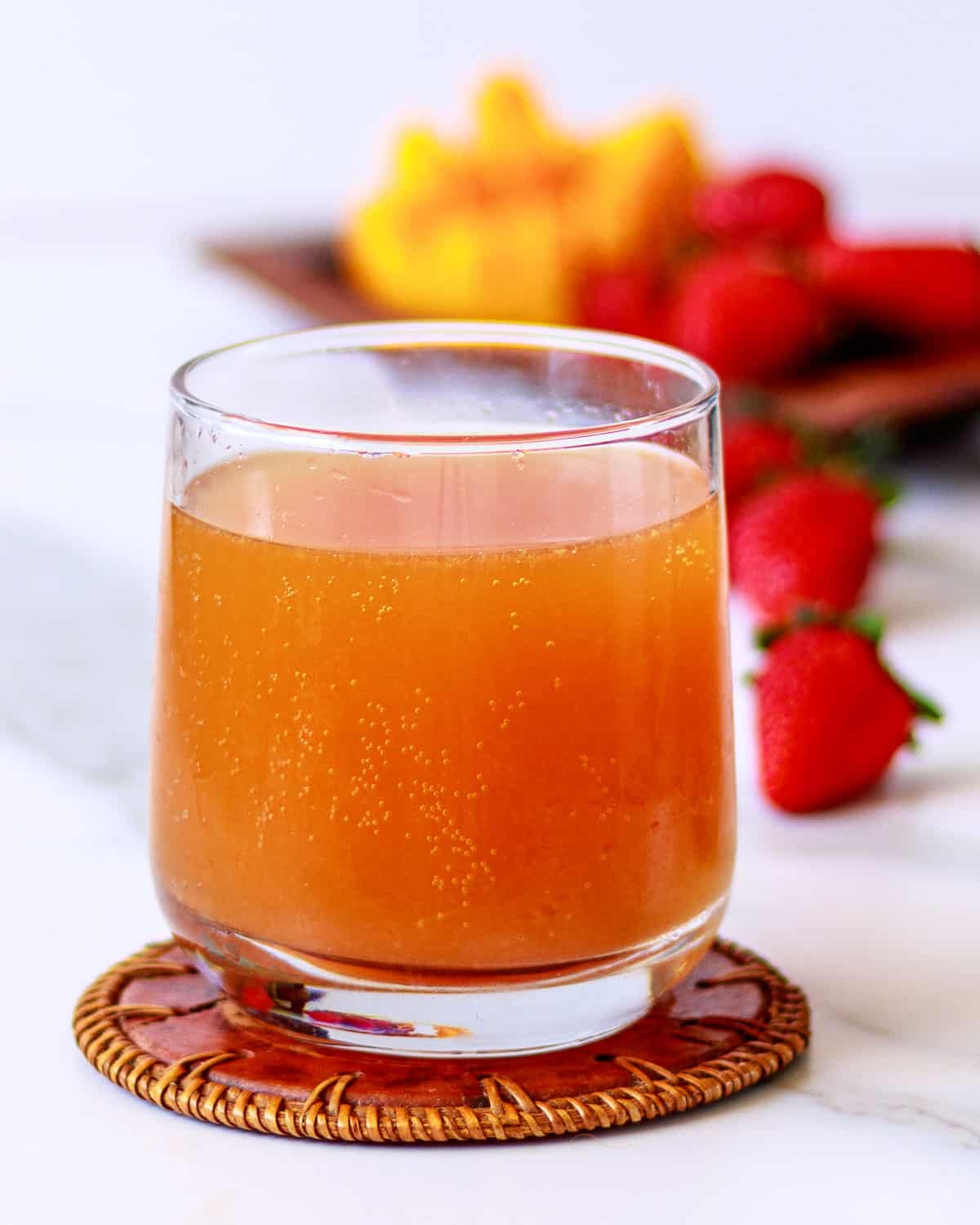
🥭 Strawberry Mango
- 1 cup mango
- ½ cup strawberries
🍍 Pineapple Turmeric
- 1 ½ cups pineapple chunks
- 1 cup chopped sliced fresh turmeric root
🍐 Spiced Asian Pear
- 1 ½ cups fresh pear
- 6 star anise pods
- 12 green cardamon pods, crushed
- 2 TB Szechuan peppercorns
- 2 TB chopped fresh ginger root
🍊 Passionfruit Orange Guava
- 1 cup diced ripe guava
- ½ cup passion fruit scooped from shells
- ½ cup fresh squeezed orange juice
- 14 cups plain kombucha
🌺 Sweet Roselle
- 1 cup fresh roselle hibiscus petals (Jamaica)
- 1 cup water
- 2 TB agave syrup
🫐 Lavender Triple Berry
- ½ cup blueberries
- ½ cup strawberries
- ½ cup raspberries
- 1 TB culinary lavender
🌱 Strawberry Purple Basil
- 1 ½ cups sliced strawberries
- ½ cup sliced purple basil leaves
So there you have it. The simple basics of doing kombucha second fermentation are well within grasp. Once you dive in, you can make your kombucha flavoring experience as unique as you like.
🥤More refreshing beverages
Enjoyed this post? Leave a comment, rate ⭐⭐⭐⭐⭐ it, and follow @poppyswildkitchen on Instagram. Aloha!
📖 Recipe
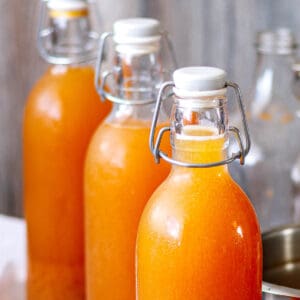
Kombucha Second Fermentation - 7 Flavors
Ingredients
Basic Ingredients
- 1 gallon homemade plain raw kombucha or unpasteurized store-bought
- 1-2 cups raw organic fresh fruit
- Optional fresh herbs and spices
Flavor variations
Strawberry Mango
- 1 cup mango diced
- ½ cup strawberries sliced
Pineapple Turmeric
- 1 ½ cups pineapple chunks
- 1 cup fresh tumeric root chopped small
Spiced Asian Pear
- 1 ½ cups fresh pear sliced
- 6 whole star anise pods
- 12 whole green cardamom pods smashed
- 2 TB Szechuan peppercorns
- 2 TB fresh ginger root chopped
Pog (Passionfruit Orange Guava)
- 1 cup ripe guava diced
- ½ cup passion fruit scooped from shells scooped from shells
- ½ cup orange juice fresh squeezed
Sweet Roselle
- 1 cup fresh roselle hibiscus petals (Jamaica)
- 1 cup water
- 2 TB agave or vegan honey
Lavender Triple Berry
- ½ cup blueberries
- ½ cup strawberries
- ½ cup raspberries
- 1 TB culinary lavender
Strawberry Purple Basil
- 1 ½ cups strawberries sliced
- ½ cup purple basil leaves sliced
Instructions
Prepare fruit
- Wash and cut organic fruit in chunks or scoop pulp from shells. You can include the seeds of fruit like passion fruit or guava. Citrus fruits should be juiced. Discard the seeds and peels. Measure according to recipe flavor.
Prepare optional herbs and spices
- Wash and slice Optional fresh herbs and spices. You can leave the skins on turmeric or ginger. They help in fermentation. Measure herbs and spices and divide them into two small bowls. This way, you can add half the total amount to each half-gallon jug for fermenting.
Blend fruit to puree
- Puree 1-2 cups raw organic fresh fruit in a blender or food processor to a liquid texture. Pour into a very large bowl.
Reserve starter liquid and SCOBY
- If using homemade kombucha, measure out and reserve 1 ½ cups from your gallon jar brew. Place it in a bowl with the SCOBY. Set aside to brew a new batch of plain kombucha.
Mix kombucha with fruit
- Pour the remainder of 1 gallon homemade plain raw kombucha into the large bowl with the pureed fruit. You should have approximately 14 cups. You can use a little kombucha to rinse your blender to include all the puree. Whisk kombucha and fruit puree to blend.
Second ferment in glass growlers
- Place a funnel over the top of one half-gallon jug. Pour half the fruited raw kombucha into the growler. Repeat with the second half-gallon jug. Divide the reserved herbs and spices between your two half-gallon growlers. Seal firmly with fermenting caps. A good hand twist is sufficient. I find using a damp wash cloth over the top of the cap helps to tighten it.
Store 2-6 days
- Place half-gallon jugs in a dark cupboard for the second fermentation. Experience will help you to judge how long to leave the jugs to build up carbonation. The next step is very important. Don't try to open warm jugs of carbonated kombucha!
Chill and strain
- Chill carbonated kombucha 12 hours before opening. Once kombucha is very cold, take jugs from the refrigerator and strain out fruit pulp, herbs, and spices. You can place a good-sized fine-mesh strainer over a bowl to strain a large batch at once.
Transfer to swing-top bottles
- Use a funnel and pour strained kombucha into swing-top bottles. Seal caps.
Store
- Kombucha stores well and stays carbonated this way easily for a week. After that, kombucha will gradually turn more and more tart while losing sweetness.

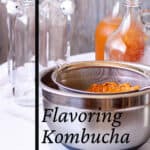
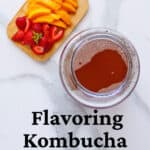
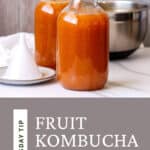
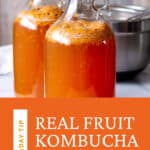
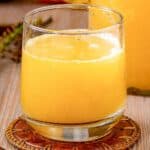
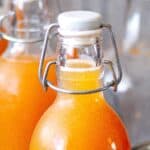
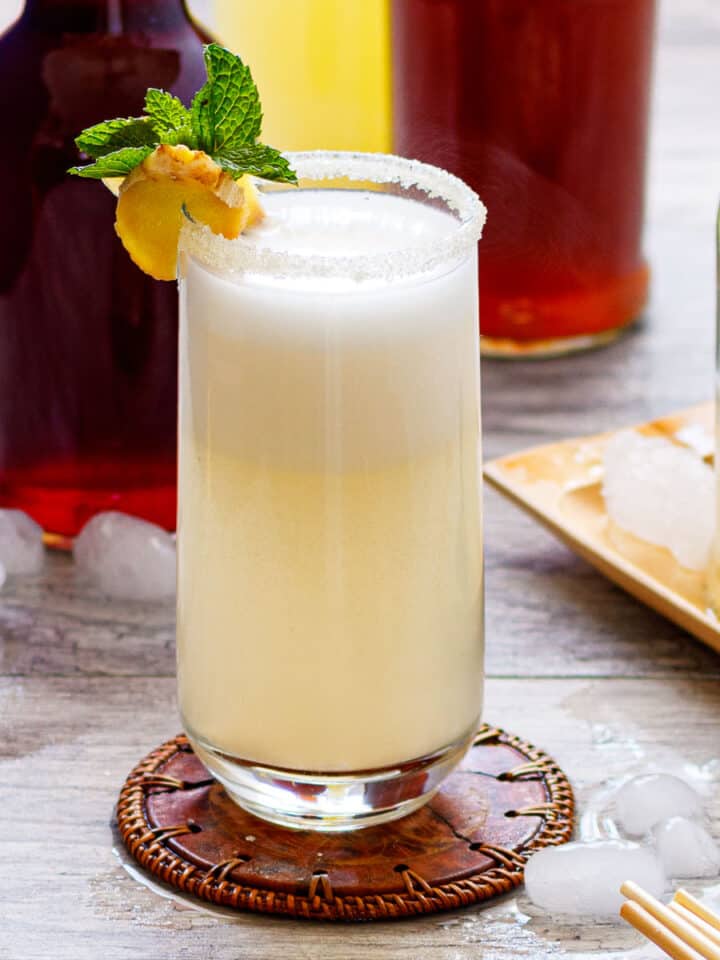
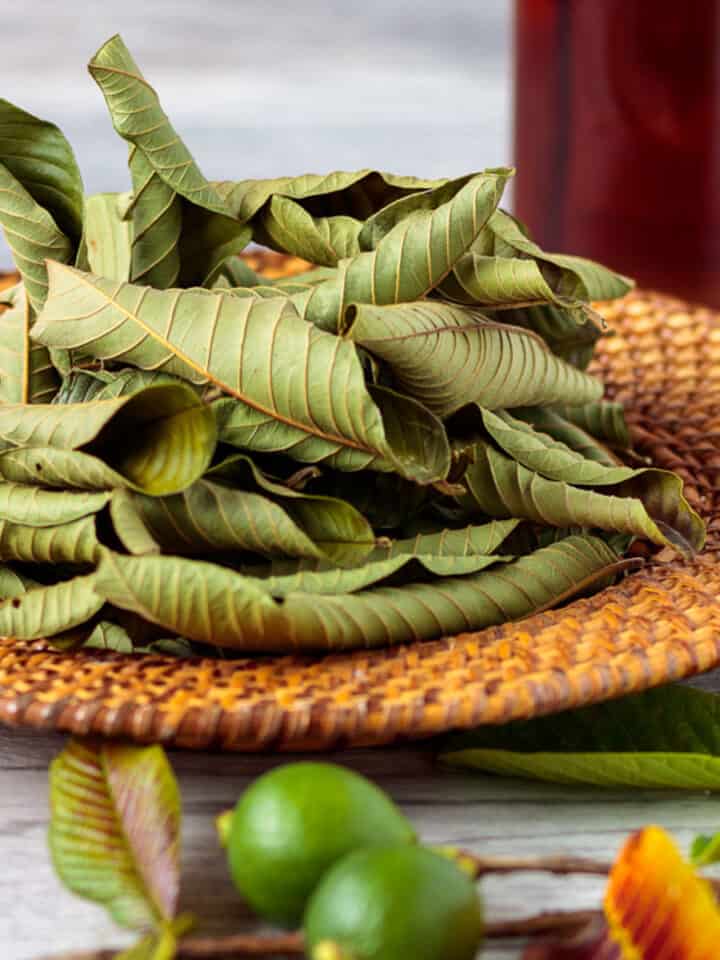
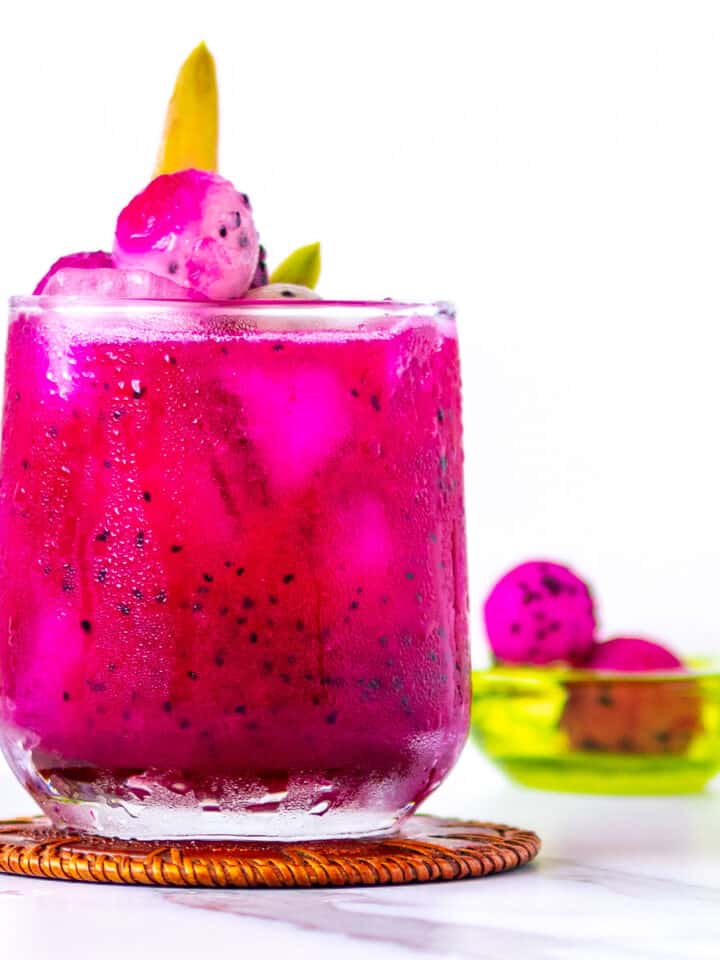
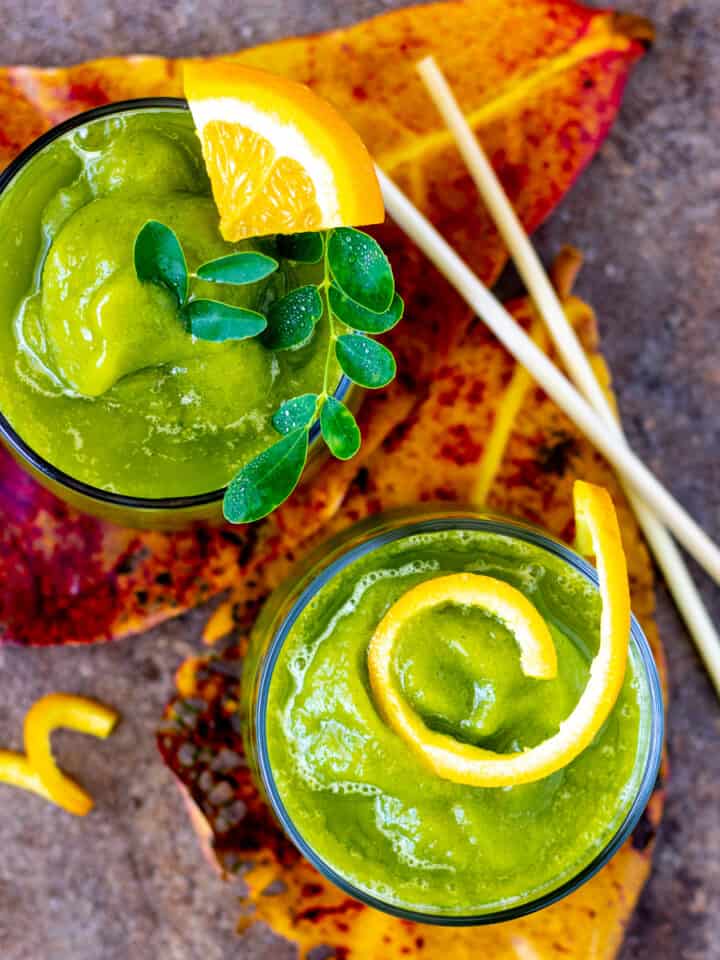
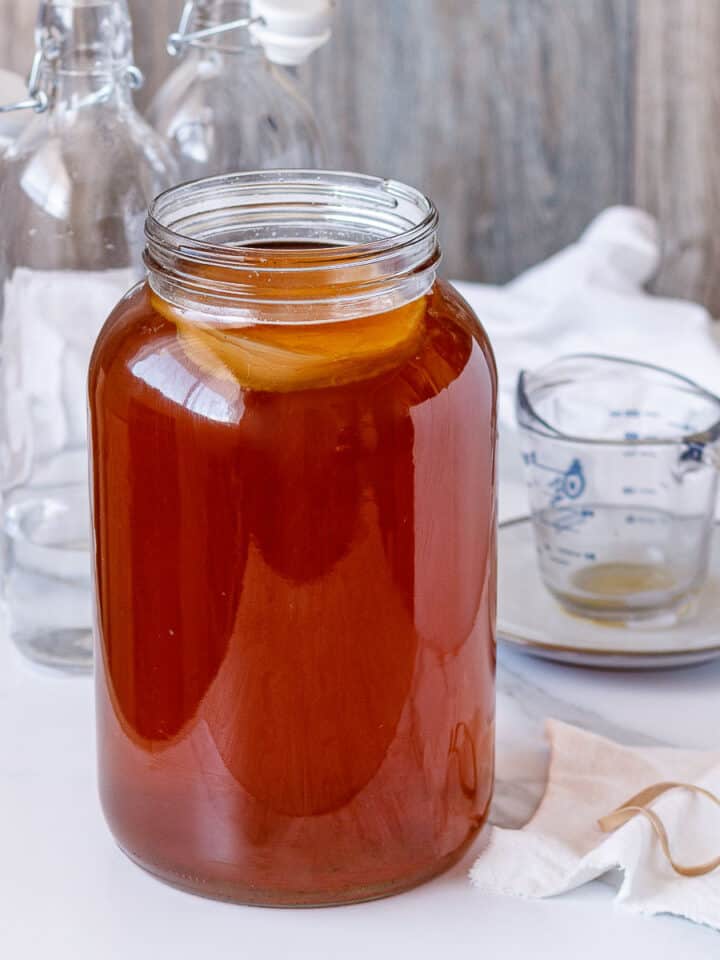
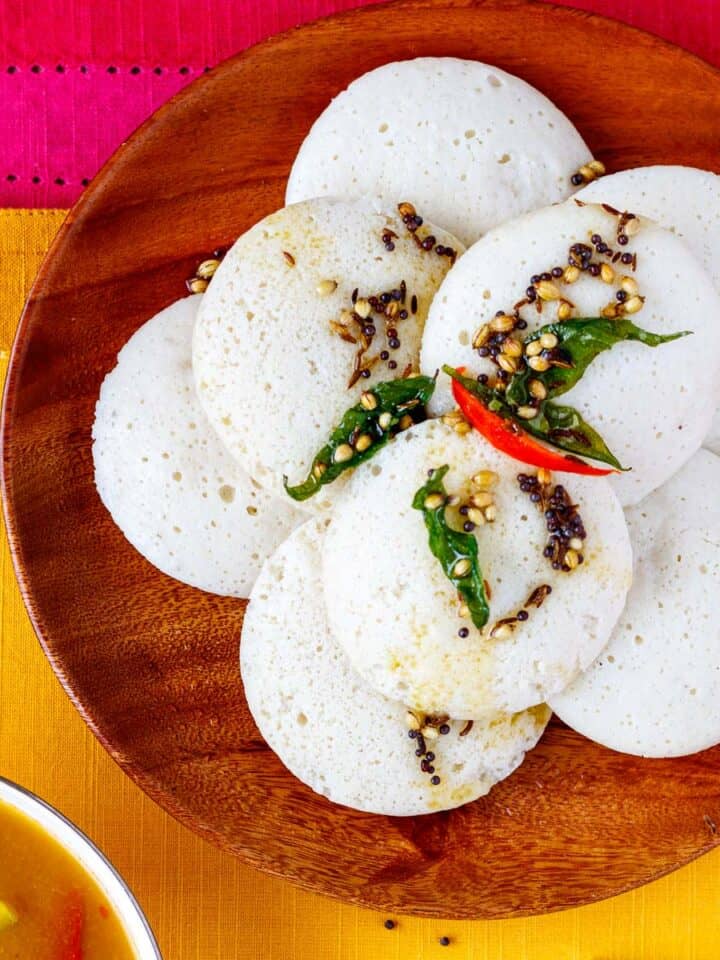
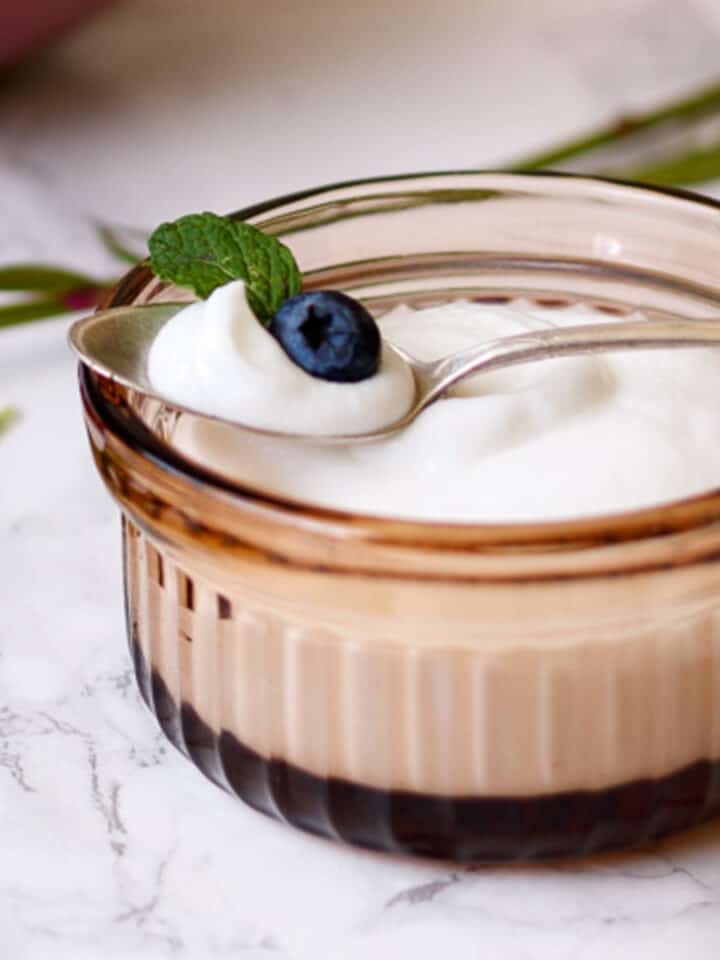
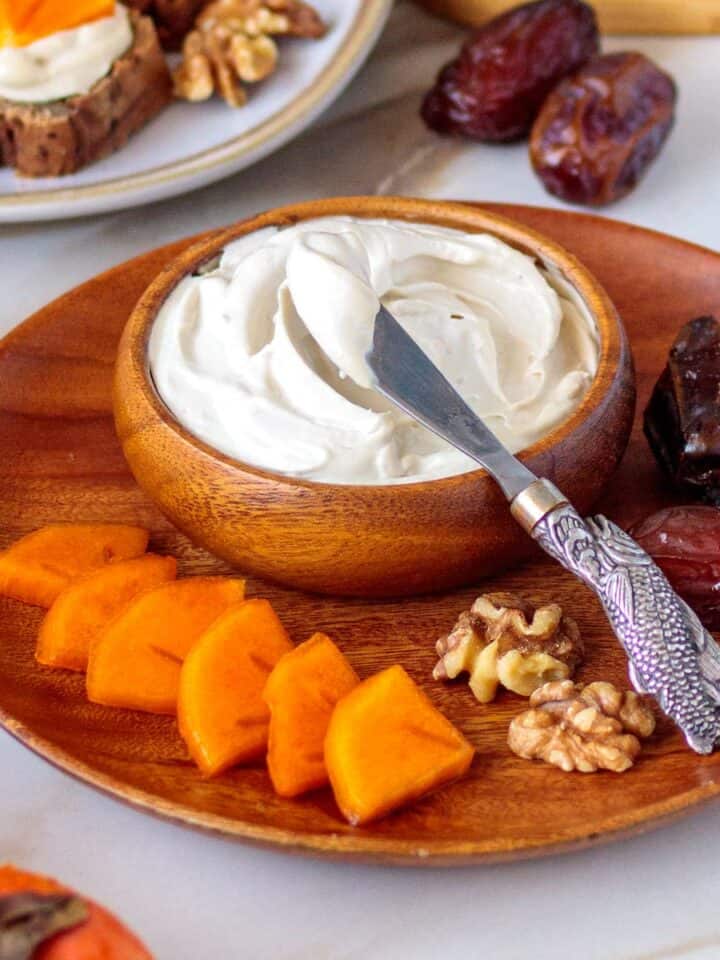
John Lindsay
Poppy,
I have a nearly 2 gallon first fermentation container. How much fruit do I need?
Poppy Hudson
You'll need 2-4 cups of fruit for 2 gallons of raw kombucha.😉
Zena
Thanks for the detailed instructions. Can you leave the ginger or some of the purée inside the bottles?
Poppy Hudson
Yes, if you like.☺️
Joe
This is really great, thank you for the recipe! I plan to use it in my current batch. I have two questions, do you strain the fruit and kombucha blend before you put it into the two half gallon containers? I believe not, but wanted to confirm.
My second question is do you lose carbonation when you filter the 2nd fermented kombucha into the bowl before you put it into smaller bowls? I ask the first question because maybe this might prevent the carbonation loss? Perhaps it's not a lot of carbonation loss?
Poppy Hudson
You are correct. Do not strain the fruit and kombucha blend before you pour it into the two half-gallon containers for fermentation. Ensuring the half-gallon containers or jars have a tight seal is very important. This is what allows carbonation and plenty of fizz to develop. My recommendation is the jars and special lids mentioned in the post. (If you are still learning how long to wait for the fermentation in your climate, you can "test" your batch in large plastic soda pop bottles. Fill one 3/4 full, and when it is tight, your carbonation has built up.) Once your brew is fizzy, you want to chill the half-gallon containers overnight before opening them. That's to prevent explosive overflow. Now,you can strain your bubbly kombucha and fruit mixture directly into jars with tight lids for storage in the refrigerator. If you strain it into a bowl before transferring it to sealed jars for storage, you will only lose a small amount of carbonation. I do it often. I hope this answers your questions and happy brewing!
Eric
These recipes are really cool! I've always bought ready-made kombuchas from this website https://www.mrlemonade.co.uk/collections/kombucha, but now I'll try making it by myself 🙂
Poppy Hudson
Wonderful!
Ruth Cooper
Aloha! I'm using a basic blender to make fruit puree for kombucha, and the fruit needs a little fluid to actually blend. Can I put a little kombucha in the blender with the fruit, or should I just add a little water?
Poppy Hudson
Absolutely! That's a good trick Ruth that I use myself sometimes.
Moni
I would like to know if I can make kombucha in a cooler home? My house rarely gets above 68 and frequently cooler in the winter. Will it just take longer or not doable?
Poppy Hudson
Hey Moni. Since the ideal temperature for brewing kombucha is 75-85 degrees, consistent temperatures at or below 68 degrees would present a challenge. It's still possible to brew at that room temperature, but you would need ways to keep your kombucha warmer, like an old blanket for insulation or a heating mat. And yes, the process would take longer. Kombucha Kamp has a great article on Winter Brewing Tips if you would like to investigate more. Here on Maui, we rarely have day temperatures below 68 degrees, no matter the season, so I hope you find the article helpful! Aloha
Jessica
It's "taut," not "taught."
Poppy Hudson
Thank you, Jessica, for your keen observation!
Wendy
This is by far the best article for Kombucha! You are the first person that Ive seen address chill before popping! I've spewed several. Thank you so much for this fantastic article!
Poppy Hudson
Wendy, I am so happy it was helpful for you! Aloha, Poppy